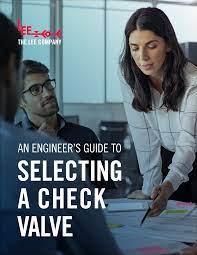- Home » Editorial » Hydraulics
Know your check valve

A check valve, also known as a non-return or one-way valve, is a mechanical device that allows a gas or liquid to flow freely in one direction while preventing reverse flow in the opposite direction. The direction in which the fluid or gas can flow is called the free flow direction; the direction in which fluid is prevented from flowing is called the checked or non-return direction.
Check valves are found in common household items. For example, when a raft or air mattress is inflated, the check valve allows air in and prevents its escape until a release is activated. Irrigation systems also use check valves; they allow water to spray out of the sprinkler head and prevent mud and rainwater from flowing back into pipes leading to the water supply
Check valve functions
The purpose of a check valve in an application will determine some design parameters. Generally, check valve functions can be divided into three categories: nonreturn, vent, and fill and drain. It is important to select the correct check valve to ensure proper functionality during system operation.
Non-return check valve
These types of check valves allow flow in one direction with minimal pressure loss and prevent flow in the opposite direction. A common application for a non-return check valve is in pump inlet and outlet ports. One check valve placed at the pump inlet allows fluid to flow from the desired source. A second check valve located at the outlet allows the pump to dispense fluid.
Vent check valve
Vent check valves are designed to open and prevent pressure build-up in a system, while preventing flow in the checked, or non-return, direction. For example, vent check valves are used to protect a vehicle’s fuel tank. Gasoline volume expands as it warms and contracts as it cools; the volume of gas in the tank fluctuates even when a car is parked. As the volume of gasoline increases, air must exit the tank to alleviate the change in pressure. The tank uses a check valve to vent air when pressure increases; this prevents damage within the tank and to connected components. The check valve also prevents debris and moisture from getting into the tank.
Fill and drain valve
These check valves permit fluid to flow into a system and prevent the fluid from escaping once it is filled. Fill and drain valves are commonly found near the tank of any hydraulic or pneumatic system. If the system needs maintenance or will be retired, safety precautions may require depressurization of the charged system. The check valves used to fill the system may be piloted open, mechanically or manually, to drain the system fluid.
How check valves work
A check valve is a direct-acting device; that means pressure acts directly upon the internal components of the valve. Check valves are typically normally closed components. They are often held closed by a force-producing mechanism within the valve. This force is minimal and returns the valve to a closed position when there is no longer a pressure differential acting on the valve in the flow direction. Some configurations have no forceproducing mechanism; they require a pressure differential in both directions to move internal components.
With a pressure differential in the flow direction, the valve opens and allows fluid to flow freely from one location to another within the fluidic system. When pressure is removed, the valve will return to its normally closed position.
When there is an increase in pressure differential in the checked, or non-return, direction, fluid flow is prevented due to the seal created by the internal components when closed. As pressure increases in the checked direction, the force to keep it closed increases. This generally improves the sealing capability of the check valve. Thus, the rate of checked direction leakage may improve with increased pressure in that direction.
An Engineer’s Guide To Selecting A Check Valve
The above content is taken from the Lee Company guide titled ‘An Engineer’s Guide To Selecting A Check Valve’, which covers the topic in more depth.
https://www.linkedin.com/company/the-lee-company/
https://www.facebook.com/TheLeeCo
-
PPMA 2025
23 September, 2025, 9:30 - 25 September, 2025, 16:00
NEC, Birmingham UK -
Advanced Engineering Show 2025
29 October, 2025, 9:00 - 30 October, 2025, 16:00
NEC, Birmingham UK










